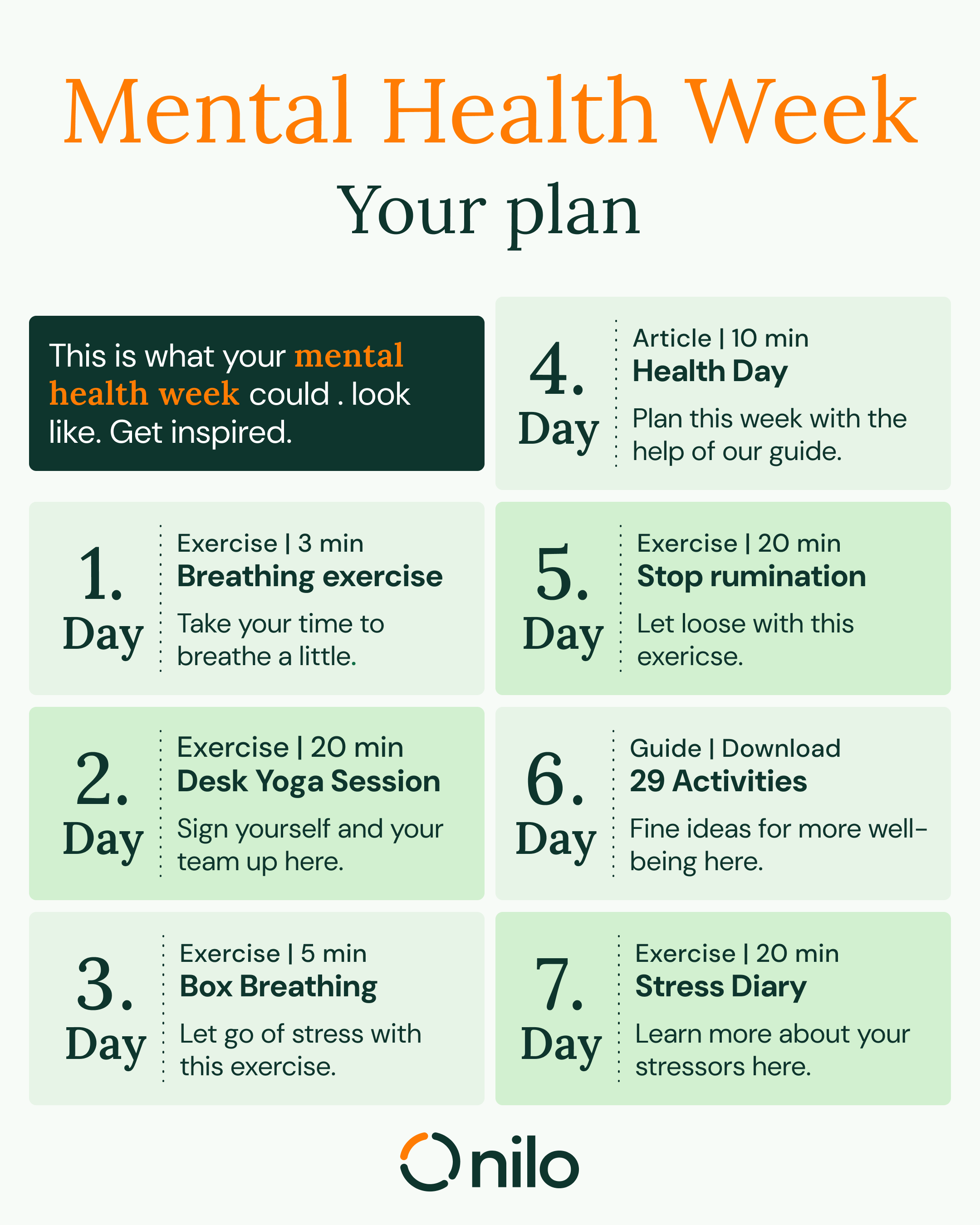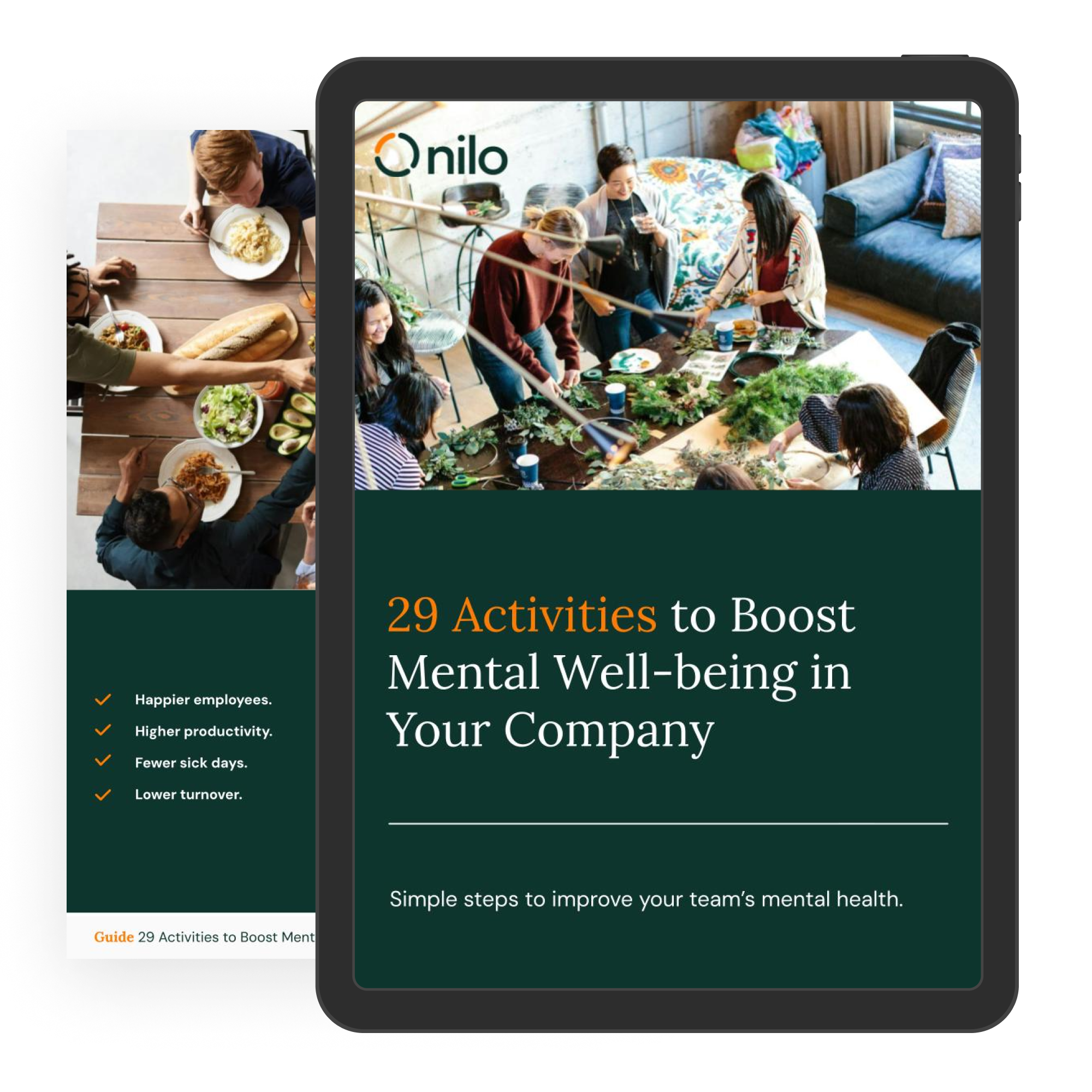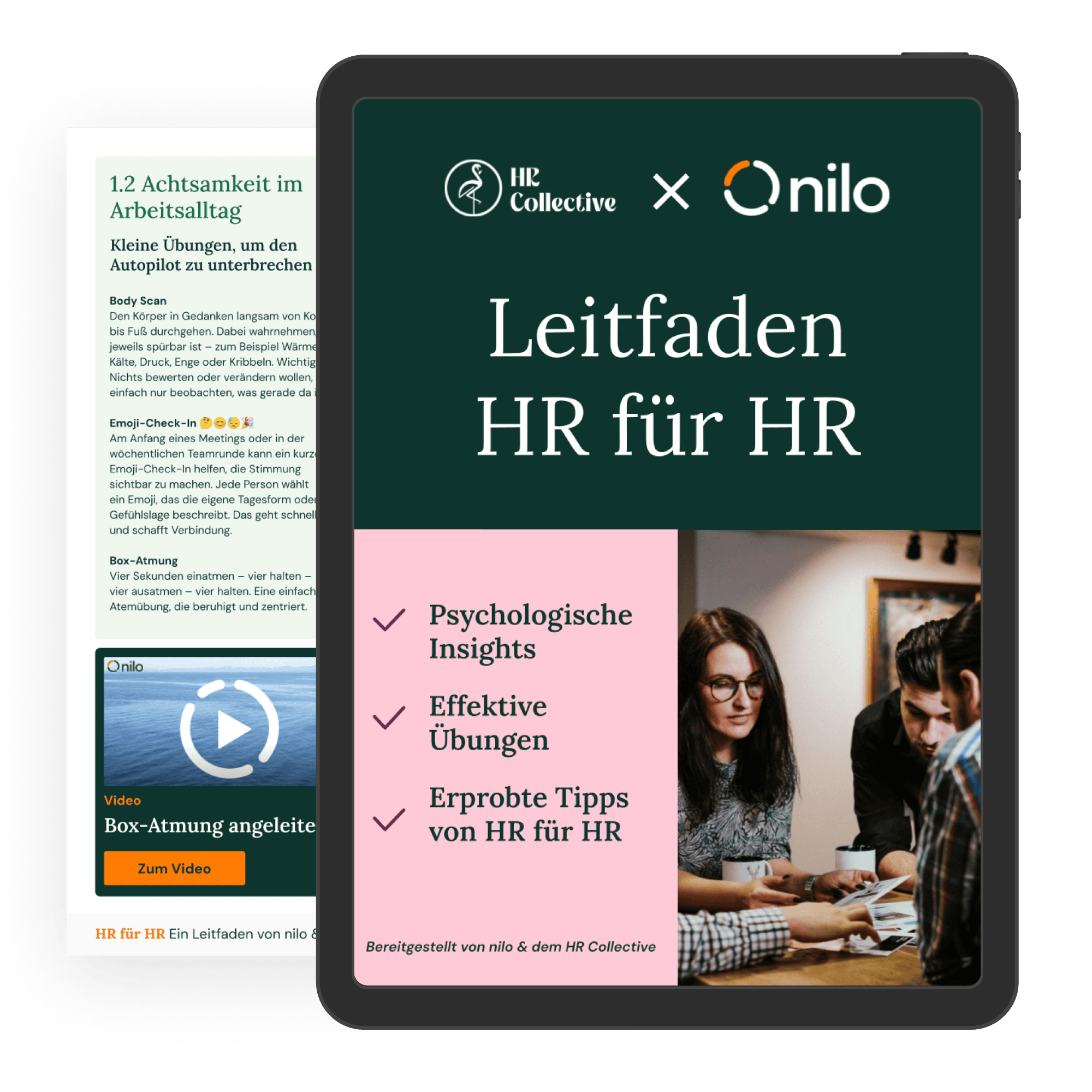Contact
It has become a key element of corporate health management in many companies: the health day. But what exactly is behind this format – and is all the effort really worth it?
A health day is a specially organized event that bundles together various activities, workshops, and hands-on offers around topics such as nutrition, exercise, mental health, or ergonomics. The goal is to raise awareness for health-conscious behavior in everyday work, encourage personal responsibility, and provide fresh inspiration for a healthy lifestyle.
Beyond that, a well-planned health day sends a strong signal of appreciation – it strengthens team spirit, can help reduce sick leave, and makes an important contribution to the team’s long-term performance.
In the following article, we’ve put together the most important basics, expert tips, and plenty of ideas for exciting activities – so that your next health day is a complete success.
Planning a workplace health day: Goals & benefits
A workplace health day is far more than a one-off event – it is a strategic tool within corporate health management. By deliberately putting physical and mental health topics in the spotlight, you not only give your employees the opportunity to engage with relevant issues, but you also set an important signal for building a lasting health culture within the company.
When done right, health days encourage people to take action – whether that means moving more throughout the day, managing stress more consciously, or adopting a healthier lifestyle. The benefits are clear: healthy employees are more productive, more satisfied, and ultimately a key factor in your company’s long-term success.
The goals of a workplace health day include:
- Raising health awareness
- Motivating employees to take responsibility for their own well-being
- Preventing illnesses & identifying risks early
- Promoting mental & physical well-being
- Fostering a healthy leadership and company culture
- Strengthening teamwork & sense of community
- Increasing satisfaction, motivation & retention
- Improving safety & overall work ability
- Reducing absences and downtime
One thing is crucial: the impact of a health day depends heavily on whether – and how – the impulses carry over into everyday work life. Only if the measures and messages remain visible after the event can a health day unleash its full potential.
Examples of health days in the workplace
A health day can be organized in many different ways – depending on the target audience, company size, and available resources. Whether traditional on-site, as an interactive information event, or fully digital: the key is that the content is relevant and engages employees actively. Here are three proven formats for inspiration:
- Modular Health Day: Stations with health checks, short consultations, trial classes (e.g. back exercises, relaxation techniques), and healthy snacks offer a structured on-site program.
- Interactive Marketplace: An open format with information booths, hands-on activities, short presentations, and spontaneous check-ups – ideal for flexible participation throughout the day.
- Digital Health Week: A week-long series of online lectures, self-tests, and movement prompts – flexible, location-independent, and perfect for hybrid teams.
Ideas for a workplace health day
A health day thrives on its content – the more relevant and diverse, the bigger the impact. The key is that, whether it’s a classic or a creative new idea, it should align with your workforce’s needs.
Theme ideas for health days
These focus areas have proven successful in many companies:
- Stress management & burnout prevention
- Back health & ergonomics
- Healthy eating in everyday work life
- Movement & fitness – even at the office
- Addiction prevention (e.g., smoking, alcohol, digital dependency)
If these ideas seem too familiar, you can bring in fresh impulses with topics like:
- Staying healthy and happy while working from home
- The sugar game – how nutrition really affects us
- Men’s and women’s health: A comparison
- Building mental strength; Training resilience
- First aid for the mind – dealing with mental stress
Activities for your health day
Once the theme or focus is set, it’s time to choose the right activities. Just like with the themes, feel free to let your creativity run wild. From classic options like body fat measurements or fitness tests to fun team challenges that spark some friendly competition, here are some ideas – from tried-and-true to unexpected:
Classics with an experience factor
- Health checks (e.g., blood pressure, body fat, eye tests)
- Fitness tests or mini team challenges
- Workshops on nutrition, exercise, or stress management
- Cooking shows or meal prep classes with local professionals
Unusual & creative formats
- Bike checks & repair stations
- Stand-up comedy with a healthy twist
- Step challenges with a reward system
- Mini-workshops on sleep & relaxation
- One-on-one consultations with experts in medicine, coaching, or psychology
- Mental Health Safe Space with psychological support
Which health days are there?
Every year, there are various national and international health days, each focusing on different themes. Some examples include:
- National Healthy Eating Day
- International Yoga Day
- Back Health Day
- World Health Day
- World Day for Safety and Health at Work
- Pain Awareness Day
The exact dates for each year can be found on websites such as the Federal Centre for Health Education (BZgA).
Examples of a health week
In addition to a health day, a health week can also be an exciting alternative.

Guide to a successful health day: Plan a health day in 5 steps
Whether it’s a small initiative or a large event, a health day stands or falls with proper preparation. With these five steps, you’ll lay the foundation for an event that really makes an impact.
STEP 1: What is the focus of your health day?
The first step is choosing the theme. Which health aspects are currently most relevant for your company? Is it about stress reduction, ergonomic work practices, or mental health? You’ll find the answer in your own data, such as:
- Results from risk assessments
- Observations during workplace walkthroughs
- Evaluations of absenteeism, overtime, or turnover
- Feedback from previous health days
- Current (anonymous) employee surveys
In larger companies, it can be useful to form a focus group with representatives from HR, occupational medicine, workplace safety, or the works council – this way, you ensure that perspectives from different areas are considered.
Tip: Many health insurance companies offer ideas, materials, and even support in organizing a health day. However, be sure to keep the event’s focus on the health aspect and not on the marketing of a single provider.
STEP 2: What goals do you want to achieve with the health day?
Once the theme is set, it’s time to define your goals. Do you want to raise general health awareness, or focus on a specific topic, such as mental health or ergonomics?
Clearly define what you want to achieve with the health day – and how you’ll measure success. Possible metrics include:
- Number of participants
- Bookings or participation rates for each activity
- Duration of participation
- Feedback ratings
- Number of actions completed
Also consider different target groups within the company: Do remote teams need digital alternatives, or are there specific formats required for certain departments?
And last but not least: What’s the available budget? This will influence the scope and type of activities you can offer.
Tip: For smaller formats with up to 30 people, you should budget at least €1,000–1,500. With a larger budget, you can offer more diverse activities – but even with a smaller budget and creative ideas, you can achieve a lot.
Important: Document your goals and planning foundations in writing – this will not only help with the implementation but also with evaluation and development in the following years.
Step 3: Plan the health day
Once you’ve defined the themes and goals, it’s time to think about what the program could look like. The following guiding questions will help you:
- When?
Which days and months are best suited? When are the most employees available on-site? Avoid overlaps with other events or vacation periods.
Tip: Use April 7th – World Health Day – as a fixed date. The WHO sets a new global health theme every year, which you can use as inspiration for your event’s content. - How long?
Should it be a full day or a half day? Could the health day be repeated regularly – for example, quarterly with changing focus areas? - How many?
How many employees do you want to reach – and how many will realistically participate? Plan the timing to avoid long wait times and overloading. - Where?
What rooms are available to you? Do you need external spaces, or can you use existing rooms (e.g., meeting rooms, the cafeteria, or break areas) flexibly?
Designing the program
Now you can plan specific activities, formats, and providers. You can find ideas in the “Measures” section above – or directly within your team: Are there any employees with health expertise, such as yoga instructors, coaches, or hobby chefs?
Tip: In addition to health insurance companies, many other partners can be involved: sports clubs, physiotherapy practices, pharmacies, gyms, nutritionists, first aid organizations, or psychological professionals. Just ask – many will be happy to collaborate!
Registration & Logistics
Depending on the program format, it might be useful to set up registration windows for certain activities – especially for one-on-one appointments or limited group sizes. Use a simple booking tool or your internal communication channel for this.
Don’t forget refreshments
Healthy snacks, water stations, or smoothie bars will provide energy – but even a simple, well-arranged fruit bowl works. Be sure to check early if your cafeteria can contribute or if volunteers will handle the catering.
STEP 4: Promote the health day in your company
To make sure everyone who should attend your health day knows about it, effective communication is key. It’s best to get support from the marketing or internal communications team for this.
Use multiple channels
- Start with an email to all employees – short, informative, and with a clear call to action.
- Use posters, flyers, or table displays in high-traffic areas like break rooms or entrances.
- Share information through the intranet, newsletters, or your communication platform (e.g., MS Teams).
- Publish an article in the company newsletter or use existing internal formats like all-hands meetings.
- Creatively designed invitations, postcards, or stickers will attract attention. If you’re on a small budget, you can still make a big impact with thoughtful touches.
Tip: Reusable giveaways, like water bottles, fruit nets, or stress balls, will stay in circulation – and keep your health day top of mind. Increase participation motivation with small challenges, raffles, or a creative theme.
STEP 5: Follow up and evaluate the health day
After ensuring everything runs smoothly on the health day itself, it’s time to follow up on your event. It’s helpful to gather feedback from as many participants as possible right after the event:
- Distribute short questionnaires at the exit
- Send digital surveys shortly after the event
- Have one-on-one conversations with colleagues
- Take notes of quotes and feedback from the team
- Capture photos to document the atmosphere
Analyze the feedback – What was well received, and what wasn’t? Which activities were most popular? Which ones might have been overlooked?
- Document learnings and ideas for next time
- Use quotes and photos for a recap on the intranet or in the company newsletter
- Review the metrics from Step 2 – were your goals achieved?
Present the results to your management – a brief summary with highlights and recommendations. And don’t forget to thank all supporters. Appreciation motivates everyone for the next round.
What happens after the health day?
A health day is most effective when it doesn’t stand alone – but is seen as the beginning of ongoing health promotion. To ensure that the impulses don’t fade away in everyday life, the day should be used as a springboard for further initiatives.
Afterward, ask yourself regularly:
- How are our employees doing – physically and mentally?
- Which activities were well received?
- Where do we need further support or new impulses?
Use the feedback and insights gathered to make targeted adjustments: with additional workshops, recurring health offerings, or focused follow-ups. This way, a one-time event becomes a sustainable part of your company culture.
Health day checklist
To make the planning and preparation easier for you, we’ve created a clear checklist based on the five steps mentioned:
1) Theme selection
- Collected existing data (HR database, risk assessments, employee surveys, etc.)
- Conducted your own survey to determine the theme
- Organized a meeting with the focus group
- Conducted online research (e.g., with health insurance companies)
- Defined themes and/or focus areas
2) Goal setting
- Formulated goals
- Defined metrics (number of participants, booking numbers, number of actions, etc.)
- Defined target groups
- Clarified the budget
- Documented all details
3) Program design
- Set date and duration
- Estimated the number of participants (based on previous health days, expected numbers)
- Defined and booked location(s) and rooms
- Brainstormed activities and collected ideas within the team
- Contacted potential internal supporters (e.g., yoga instructors)
- Identified and contacted external partners
- Defined concrete offerings
- Established registration processes
- Clarified catering arrangements
4) Communication
- Requested support from other departments (marketing, communications)
- Communicated the event via email
- Planned and implemented additional communication measures
5) Follow-up
- Distributed and/or sent out feedback forms
- Collected feedback in one-on-one conversations
- Reviewed and sorted photos
- Analyzed metrics
- Published success reports in internal media
- Communicated event summary to leadership
FAQ – Frequently asked questions about the health day
How can we achieve the highest possible participation rate?
To achieve a good participation rate at your health day, you can focus on the following points:
- Do the content and formats meet your team’s needs? You can check this in advance with a survey or one-on-one conversations.
- Was the date communicated early enough? Calendars fill up quickly, so an early announcement ensures more availability.
- Were different communication channels used? Not everyone is reached through the same channels, so it’s important to communicate in a variety of ways. Possible channels include emails, intranet posts, invitation videos, flyers, posters, announcements during all-hands meetings, and communication tools like MS Teams.
- Was communication continuous or repeated? Use the time leading up to the health day to tease different activities and give sneak peeks of what employees can expect. This will build excitement and keep the event on the team’s radar.
- Is the registration process easy? If your health day requires registration, make it as simple as possible, such as through a quick confirmation on your communication platform.
How can companies further promote employee health?
There are many ways to implement workplace health initiatives. Some examples include:
- Setting up ergonomic workstations, such as adjustable desks
- Promoting healthy eating, for example through nutritional counseling
- Encouraging movement at work, with offerings like desk yoga, bike leasing, or similar programs
- Supporting mental health, for example through platforms like nilo or in-house psychologists
If you’re organizing a health day, it’s a good idea to think in advance about how to continue the initiatives after the event. You could regularly remind your colleagues about the topics and send them motivating and inspiring content. Or, do you have relevant courses or webinars in your BGM program that you could suggest to participants?
Is a health day enough as a measure in workplace health management?
In short: no. A single health day is not enough to create a lasting impact in workplace health management (WHM).
Time and again, companies start their WHM initiatives with a one-off health day – and stop there. But that’s not how it works. A health day can be a valuable catalyst, drawing attention and kick-starting initial measures. It’s ideal for raising awareness among employees, highlighting key topics, and sparking motivation.
However, without follow-up integration into daily work life, clear responsibilities, and ongoing offerings, the day quickly loses its impact. To turn a one-off event into genuine health promotion, follow-up measures are necessary – along with someone who continuously develops and drives them forward.
A health day is therefore not the goal, but the beginning. It sets the stage – the real performance happens afterward.
How much does a health day cost?
The cost of a health day varies depending on its scope, program content, and external support. For smaller formats with basic offerings such as workshops, short presentations, and simple check-ups, you should budget around €1000 to €1500.
Larger health days with multiple modules, individual consultations, or external experts can be significantly more expensive – depending on the provider and the effort involved. However, discounts are often available for multiple bookings or when combined with other initiatives.
Many health insurance providers offer financial support or, under certain conditions, may even cover the entire cost of a health day. It’s worth getting in touch early to explore funding options and organizational support.
i




